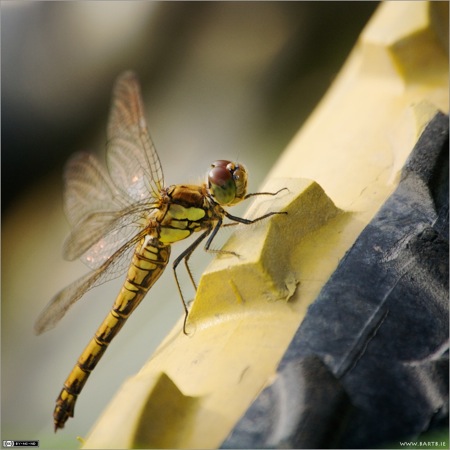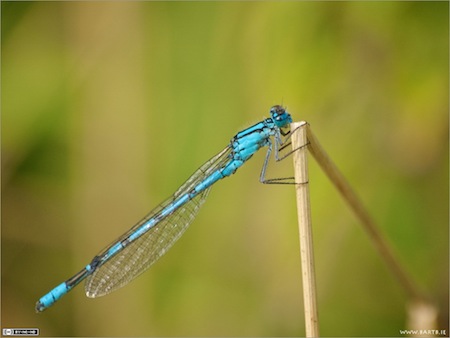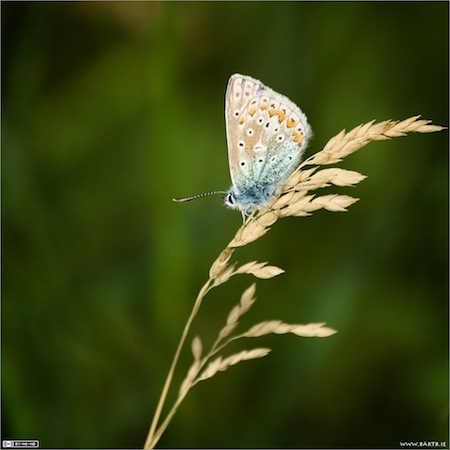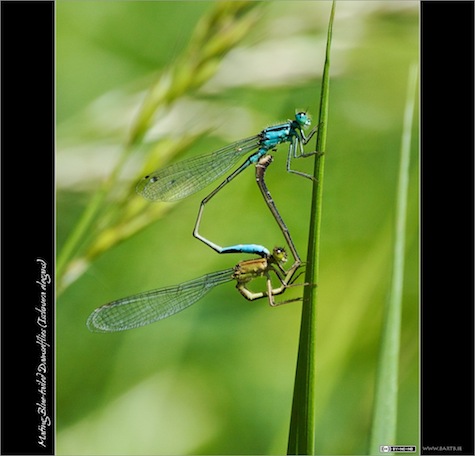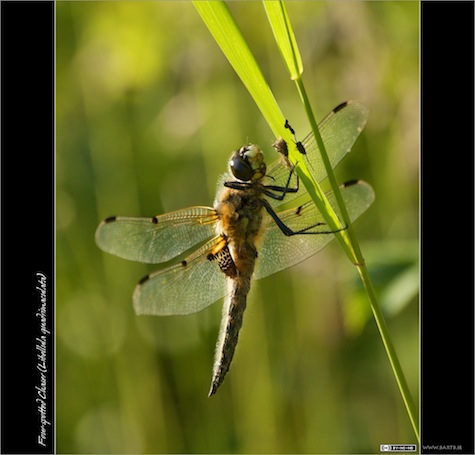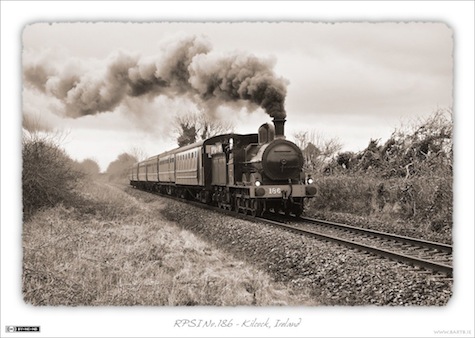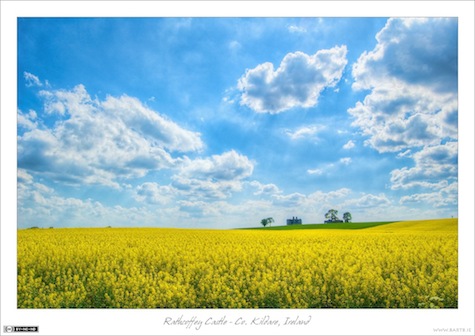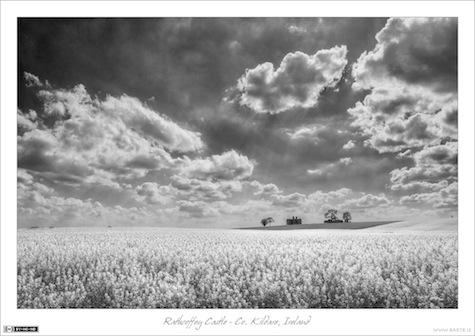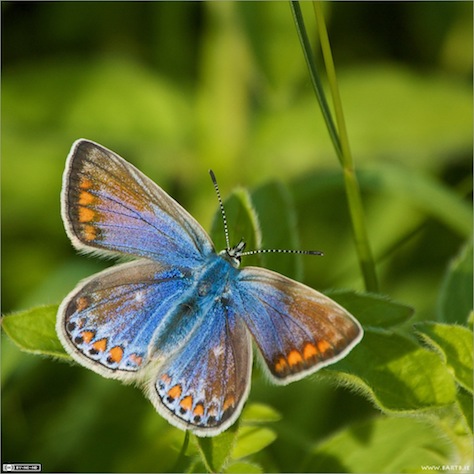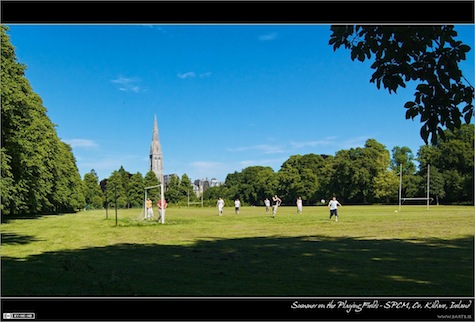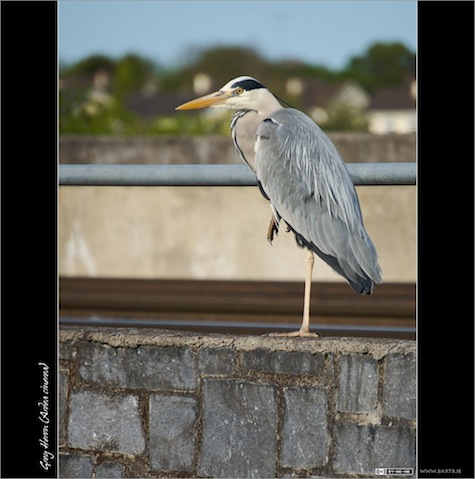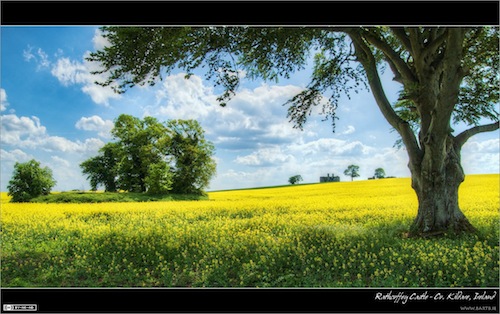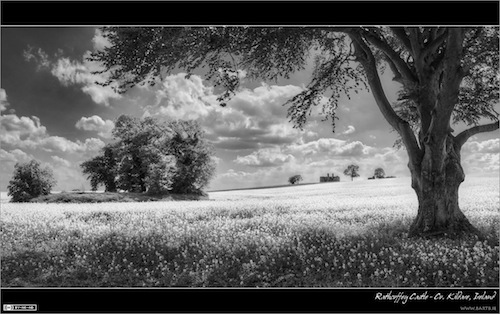Dec
22
Photo of the Week 149 – Common Darter
Filed Under Photography on December 22, 2010 | Leave a Comment
I’ve had quite enough of all this snow and cold at this stage, so I thought I’d go back to some shots from my new project this year, dragonflies and damselflies. The shot I’ve chosen for today shows a very common kind of dragonfly we see a lot around rivers, lakes, and canals in Ireland, the Common Darter (Sympetrum striolatum). This shot was in some ways very serendipitous – I’d put my bike down along the canal and was waiting for some butterflies or dragonflies to come by, when I noticed that the yellow walls of the the tyres on my bike seems to actually attract this guy! Maybe it looked like a massive yellow flower or something, or maybe it was just nice and warm. What ever his reason was, he sat there happily for about 10 minutes, and let me get as close to him as my lens could focus. I tried about 100 shots from different angles, with different depths of field, and with and without varying amounts of fill flash, but I settled on this one as my favourite. To give you some idea of how ruthlessly I often edit my images down, of the approximately 100 shots I took of this guy, I kept five!
- Camera: Nikon D40
- Lens: Nikon DX AFS 55-200mm
- Exposure: 1/400 sec
- Focal Length: 200mm
- Focal Ratio: f/8
- ISO: 400
- Camera Mode: Aperture Priority
- Flash: manually turned on (for fill flash)
- Flash Exposure Compensation: -3.0ev
- Processing: cropped to a square and tweaked with Aperture’s built-in Dodge & Burn plugin
Nov
24
Photo of the Week 145 – The Common Blue Damselfly
Filed Under Photography on November 24, 2010 | Leave a Comment
Last summer I mostly concentrated on wild flowers and Butterflies, this summer, I concentrated on Butterflies, Dragonflies and Damselflies. I’ve already shared a lot of my Butterfly shots in this series, and a Dragonfly one earlier in the year, so now I thought I’d share one of my favourite Damselfly shots from this summer.
This little guy is a male Common Blue Damselfly (Enallagma cyathigerum). As their name suggests this species are very blue, and not very rare, at least not along the banks of the Royal Canal. There is a complication though, there are three common species of blue damselfly along the canal, and they can look very similar to each other indeed! The key to telling them apart is the exact details of their markings. This angle doesn’t show it very well, but the Common Blue has a club-shaped black mark on the first segment after the wings. If you look carefully you can just about see it in this shot. If that club-shaped marking were to be u-shaped instead, then this would be an Azure Damselfly (Coenagrion puella).
These guys are smalL shy, and very fast, which makes them quite challenging to photograph. I don’t have a traditional macro lens anyway, but if I did, I don’t think I’d use it for Damselfly shots anyway. All my Damselfly (and most of my Butterfly) shots are taken with my trusty 55-200mm zoom, usually at full stretch at 200mm. Using a zoom rather than a macro lets me get closeup shots from a little further away, though it does come at a price. Zoom lenses compress distance, and the closer you are to your subject, the more pronounced this effect is. This results in a very shallow depth of field, so you need to stop down quite a bit before you get enough depth to get meaningful shots. Zooming in also magnifies any little shake in your hand, so as well as using a small aperture to get the DOF, you also have to use a fast shutter speed to get sharp focus. Both a small aperture and a fast shutter cut down the light a lot, so you really need a lot of light to get the shot – so, you generally need to shoot on sunny afternoons. This is not that big of a problem though, because Damselflies like the sun too! With a lot of patience and perseverance, and perhaps a little luck, you can get some nice shots of these wonderful insects without the need for fancy expensive kit.
As I tried more and more damselfly shots over the summer, I soon got plenty of sharp ones, but the problem was getting a good background. These little fellas like to hide between long grass, so you tend to get grass poking into the frame all over the place, causing a lot of clutter in the background, and often even sticking in front of parts of the insect’s body, wings or tail. My perseverance paid off though, and later in the summer I got lucky when this guy posed for me on the tallest blade of grass along a bank – he was close to eye-level, and was happy to sit there while I got close enough to get this shot. Because he was on the tallest blade of grass, there was no clutter to get in the way, and I was able to angle the camera to get the nearest background object to be far enough away to be fully out of focus, giving this nice uncluttered shot
- Camera: Nikon D40
- Lens: Nikon DX AFS 55-200mm
- Exposure: 1/400 sec
- Focal Length: 200mm
- Focal Ratio: f/8
- ISO: 400
- Camera Mode: Aperture Priority
Nov
1
Photo of the Week 142 – The Common Blue
Filed Under Photography on November 1, 2010 | 1 Comment
One of my favourite muses this year has been the Common Blue butterfly (Polyommatus icarus). It’s just so beautiful, and this was a good year for them in Ireland. The summer’s long gone now, but it comes back to me vividly when I look at this shot.
This is definitely one of my favourite shots of the Common Blue from this year. In many ways this is very clichéd shot, these guys love sitting on grass seed stalks, so you see loads of shots of them in this pose. However, this ones stands out to me because of the wonderful soft evening light, and the strong contrast between the butterfly and the background. This was possible because this guy was friendly enough to sit on a grass stalk that was in sunlight, while the background behind it was in shade.
- Camera: Nikon D40
- Lens: Nikon DX AFS 55-200mm
- Exposure: 1/400 sec
- Focal Length: 200mm
- Focal Ratio: f/8
- ISO: 400
- Camera Mode: Aperture Priority
- Exposure Bias: -0.7ev
Aug
24
Photo of the Week 130 & 131 – Two New Muses
Filed Under Photography on August 24, 2010 | 2 Comments
For a long time now my two favourite subjects have been trains and butterflies, but this year I’ve started to be attracted by two related new muses. Butterflies are probably the most eye-catching insects in Ireland, but I think the largest are the Dragonflies and Damselflies that fill our summer skies. I’ve only been focusing on these guys for a few months, but I’ve already got some pictures I like enough to include here.
The first shot I’ve chosen shows a pair of Blue-tailed Damselflies (Ischnura elegans) making more Blue-tailed Damselflies. Two things to note here, firstly, Damselflies opt for a very unique position for mating, and the males and females have very different colours. Adult males of the different species generally look quite distinct (with a few exceptions), but many of the females of the different species look very similar, some species even have females of a few different colours, and to really confuse things, both males and females change colour as they mature. If you can’t recognise what species a Damselfly is, it’s probably a juvenile, or a female, or both. Butterflies are WAY easier to tell apart!
- Camera: Nikon D40
- Lens: Nikon DX AFS 55-200mm
- Exposure: 1/800 sec
- Focal Length: 200mm
- Focal Ratio: f/8
- ISO: 200
- Camera Mode: Aperture Priority
- Exposure Bias: -1.0ev
- Processing: tweaked a little using Aperture’s Dodge & Burn plugin
The second shot I chose is of the largest Dragonfly I’ve managed to capture so far, the Four-spotted Chaser (Libellula quadrimaculata). These guys are very territorial. They get their name because they chase away other Dragonflies that stray into their patch (and have 4 spots on each set of wings). They like to sit on perches that give them a good view of their territory, and will keep returning to their favourite perches over and over again. This makes them a joy to photograph, if you miss the perfect shot the first time around, just wait a bit, and you’ll get another chance! The fact that they like a perch with a good view also means you tend to be able to get shots with nice clutter-free backgrounds too.
I’ve also started to experiment a lot with back-lighting in the last few months. As this shot demonstrates, it can work nicely on insects which tend to have transparent or semi-transparent bits for the light to shine through.
- Camera: Nikon D40
- Lens: Nikon DX AFS 55-200mm
- Exposure: 1/400 sec
- Focal Length: 200mm
- Focal Ratio: f/8
- ISO: 400
- Camera Mode: Aperture Priority
- Exposure Bias: -1.0ev
- Processing: tweaked a little using Aperture’s Dodge & Burn plugin
Aug
9
Photo of the Week 129 – No. 186 Steaming West
Filed Under Photography on August 9, 2010 | 1 Comment
Since it’s been a while since I posted a railway shot in this Photo of the Week series, I thought I’d treat myself by posting my favourite steam shot of the year (so far). I chose this location precisely because it’s free from modern distractions. There are no modern houses, no electricity pylons, no modern signals, no modern electronics cabinets, in short, nothing to break the illusion of timelessness. OK – that’s not entirely true. Those of you with a very keen eye will notice the one unavoidable piece of modernity in this shot – the track itself – it’s continuous welded rail on concrete sleepers. You can rest assured that when No.186 was earning it’s keep for the Great Southern & Western Railway it wasn’t running on anything nearly as fancy, smooth, or comfortable! Still – very few people will find the modern track-work a distraction from the timeless beauty of a steam engine hard at work.
For those of you interested in such details, this is RPSI preserved steam loco number 186. She’s a class J15 0-6-0 former GS&WR loco, manufactured in Manchester in 1879, and retained in service until 1964. Here we see her on a cold, windy, and rather damp Easter Monday morning near Kilcock Co. Kildare, working the Easter Egg-spress from Dublin to Mullingar.
- Camera: Nikon D40
- Lens: Nikon DX AFS 55-200mm
- Exposure: 1/640 sec
- Focal Length: 55mm
- Focal Ratio: f/5.6
- ISO: 800
- Camera Mode: Full Manual
- Processing: This shot was first tweaked using the Topaz Adjust plugin in Photoshop Elements 8, then converted to monochrome using the Monochrome Mixer in aperture, and then give a subtle sepia tone using the Colour Monochrome brick in Aperture.
Aug
2
Photo of the Week 127 & 128 – Big Summer Skies
Filed Under Photography on August 2, 2010 | Leave a Comment
I’ve been on a bit of a break from Photography – a combination of injury and crap-tacular weather, so I have yet another catch-up post to do! As always when I do multiple posts, the two images are related, in this case, very related, being two different treatments of the same RAW image. This shot was taken on the same day as the last monochrome-colour combo I posted (Photo of the Week 111 & 112 – Summer in Rathcoffey), and from a spot only a few hundred feet from where that last shot was taken.
Yesterday I posted some of my thoughts on Photographic composition, and used that post as the basis for a conversation with Allison on episode 271 of the Nosillacast podcast. In that discussion we talked about the importance of getting layers into photographs of places to give a sense of depth, and in particular we talked about the importance of the foreground layer. As part of that discussion I drew attention to the fact that there are a huge amount of possible foregrounds for every background. You can usually move hundreds of feet without making much, if any, change to the background when you’ve shooting landscapes. This gives you a wide menu of foregrounds to choose from.
If you compare and contrast these photos with those from my Photo of the Week 111 & 112 post, you’ll get a good example of just how different a shot you can get by just changing the foreground. Both sets of photos have Rathcoffey Castle as the background, both have the field of flowering Rape Seed flowers as the mid-ground, and both have the same dramatic sky at the top of the frame, but both have very different foregrounds, framings, and compositions, resulting very different photographs.
These shots have a far simpler composition, with far fewer elements in the frame. It really is just the field, the castle, and the sky. The previous shot was about showing the many interesting things around the edges of the field, the beautiful old tree, the ancient Ring Fort, and of course the castle, so it was composed in such a way as to show all these things without cluttering the frame. The filed and the sky were in that shot too, but they were almost incidental. Here, we have much less in the frame, so both the sky and the big sweeping field are the stars of the show, with the castle adding some nice interest to the background, but not being the star of the show.
These two sets of shots were taken very close to each other. The first a little to the left of the Ring Fort, with the Ring Fort included, the other a little to the right of the Ring Fort with it excluded. The Ring Fort is literally just a few pixels off to the right of this shot, but because you don’t see it, you assume it’s not there, and that the field goes on for ever. As it happens it really is a very big field, but doesn’t come across half as well in the shot if you include it’s edges.
As with the previous photos, this pair was generated using the workflow I described on the Typical Shutterbug Podcast.
- Camera: Nikon D40
- Lens: Nikon DX AFS 18-55mm (D40 kit lens)
- Exposure: 1/1250 sec
- Focal Length: 18mm
- Focal Ratio: f/8
- ISO: 200
- Camera Mode: Aperture Priority
- Processing: single RAW image first tonemapped with Photomatix Pro, then tweaked with the Topaz Adjust 4 plugin in Photoshop Elements
- Camera: Nikon D40
- Lens: Nikon DX AFS 18-55mm (D40 kit lens)
- Exposure: 1/1250 sec
- Focal Length: 18mm
- Focal Ratio: f/8
- ISO: 200
- Camera Mode: Aperture Priority
- Processing: single RAW image first tonemapped with Photomatix Pro, then tweaked with the Topaz Adjust 4 plugin in Photoshop Elements, and finally converted to monochrome using the Channel Mixer in Apeture
Jul
18
Photo of the Week 126 – Female Common Blue Butterfly
Filed Under Photography on July 18, 2010 | 2 Comments
I have quite a few good butterfly shots in reserve for future Photo of the Week posts, but I want to keep things nice and varied, so I’m only going to be posting one every few weeks. Since it’s been over a month since I shared a butterfly shot, I figure it might be time to share another.
This is a shot that I had been chasing for over a year when I finally managed to captured it last month. The Common Blue butterfly (Polyommatus icarus) is very small, and very camera shy, but also very beautiful. The male’s back is plain electric blue, which is pretty spectacular, but the female takes things to a whole new level, having a beautiful mix of browns, blues, and oranges on her back. The patterns at the tips of her wings are both intricate and beautiful. Many people consider this the most colourful Irish butterfly, though I disagree, I think that honour should go to the Peacock Butterfly. Regardless of whether or not it’s the most colourful butterfly, it’s certainly one of the most beautiful.
The best chance you’ll get to capture the back of these fine lady’s wings is in the evening time. As the wind falls and the sun gets low in the sky, you’ll sometimes find them sun-bathing on top of tall stalks of grass or wild flowers like thistles with their wings open. If you approach very slowly and very carefully with a long enough lens you have a chance of getting off a good shot. I took this one on a beautiful still and clear summer evening along the banks of the Royal Canal near Deey Bridge and the 13th lock with my 55-200mm zoom zoomed in all the way to 200mm.
- Camera: Nikon D40
- Lens: Nikon DX AFS 55-200mm
- Exposure: 1/400 sec
- Focal Length: 200mm
- Focal Ratio: f/8
- ISO: 400
- Camera Mode: Aperture Priority
- Exposure Bias: -0.7ev
- Processing: This shot was tweaked a little using Aperture’s Dodge & Burn plugin to selectively add brightness, contrast, and saturation to the butterly
Jul
11
Photo of the Week 125 – Soccer on the Playing Fields
Filed Under Photography on July 11, 2010 | Leave a Comment
I’m not even the smallest bit of a football fan, but given that it’s World Cup final weekend, I figured this would be a good time to share one of my few football photos. As well as being beautiful, the grounds of St. Patrick’s College provide a great amenity for the people of Maynooth. Here we see some local lads enjoying a kick-around on one of the pitches on the so-called Playing Fields a fantastic summer afternoon. In the background you can see the spire of the Gunne Chapel (the college chapel).
- Camera: Nikon D40
- Lens: Nikon DX AFS 18-55mm (D40 kit lens)
- Exposure: 1/1000 sec
- Focal Length: 18mm
- Focal Ratio: f/8
- ISO: 400
- Camera Mode: Aperture Priority
- Exposure Bias: -0.7ev
- Processing: This shot was edit using both the Topaz Adjust and Topaz Detail Photoshop plugins.
Jul
4
Photo of the Week 124 – Grey Heron
Filed Under Photography on July 4, 2010 | 2 Comments
In my mind the most beautiful bird we have in Ireland is the Grey Heron (Ardea cinerea). Others may disagree, but I’ve always loved these big, elegant, but rather skittish birds. Because they’re so easily frightened even a 200mm zoom often isn’t enough to get a great shot, but sometimes you get lucky, and you run into one that’s a little braver than most, and you can get a good shot without the cannon-sized lenses the Scott Bournes of this world use.
In Leixlip there’s a massive viaduct that takes the Royal Canal, its towpath and the Dublin to Sligo railway line across the river Rye and its rather large valley. This heron was sitting on the wall separating the railway from the canal on the viaduct, and he didn’t fly away even when I got right to the edge of the canal on the towpath. I was still a good 5 meters away, but I don’t usually manage to get even nearly this close.
- Camera: Nikon D40
- Lens: Nikon DX AFS 55-200mm
- Exposure: 1/800 sec
- Focal Length: 200mm
- Focal Ratio: f/5.6
- ISO: 200
- Camera Mode: Aperture Priority
Jun
27
Photo of the Week 122 & 123 – Summer in Rathcoffey
Filed Under Photography on June 27, 2010 | 5 Comments
Last weekend the weather was just too good to sit inside working on a computer, so I didn’t find the time to post a photo of the week. This means we’re playing catch-up today with a double posting. As usual for a multiple post, I’ve chosen a theme to link the shots, in this case, both were generated from the same original RAW image from the camera!
Both shots show a wonderful view taken from a back road near Maynooth in Co. Kildare Ireland. The road is at the bottom of a sweeping hill at the top of which stand the ruins of Rathcoffey Castle. The farmer grows Rape Seed on the hill, so when that crop is in bloom, you get this amazing scene where the whole field is bright yellow, truly spectacular!
The fist shot I’m posting is the colour version, this is a panoramic crop, and was generated from a single RAW file by first tonemapping it with Photomatix Pro, and then tweaking the resulting image a little using the Topaz Adjust 4 plugin in Photoshop Elements. You might ask why the image needed to be tonemapped? The simple answer is that the difference in brightness between the land and sky were just too great to properly expose both in a single traditional exposure. Exposing either correctly would result in the other being badly under or over exposed. Tonemapping allows both to be properly exposed at the same time.
- Camera: Nikon D40
- Lens: Nikon DX AFS 18-55mm (D40 kit lens)
- Exposure: 1/800 sec
- Focal Length: 18mm
- Focal Ratio: f/8
- ISO: 200
- Camera Mode: Aperture Priority
The second shot was generating by using the first as a starting point, and then using the channel mixer to generate a monochrome version. The channel mixer allows you to choose how much of each colour goes into the black & white version of the image. By turning down the blue channel you can get stunning black skies which make for really dramatic photos.
- Camera: Nikon D40
- Lens: Nikon DX AFS 18-55mm (D40 kit lens)
- Exposure: 1/800 sec
- Focal Length: 18mm
- Focal Ratio: f/8
- ISO: 200
- Camera Mode: Aperture Priority







